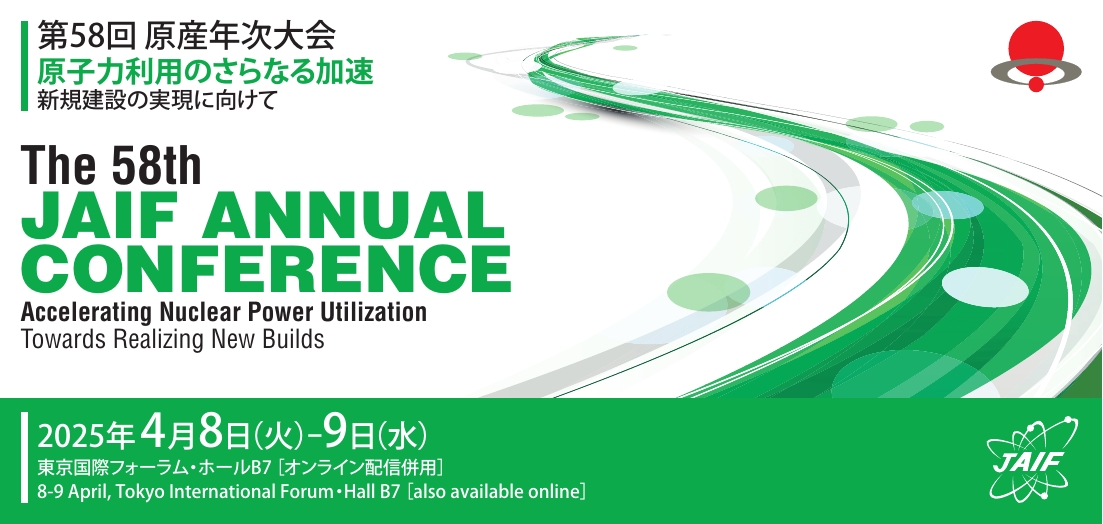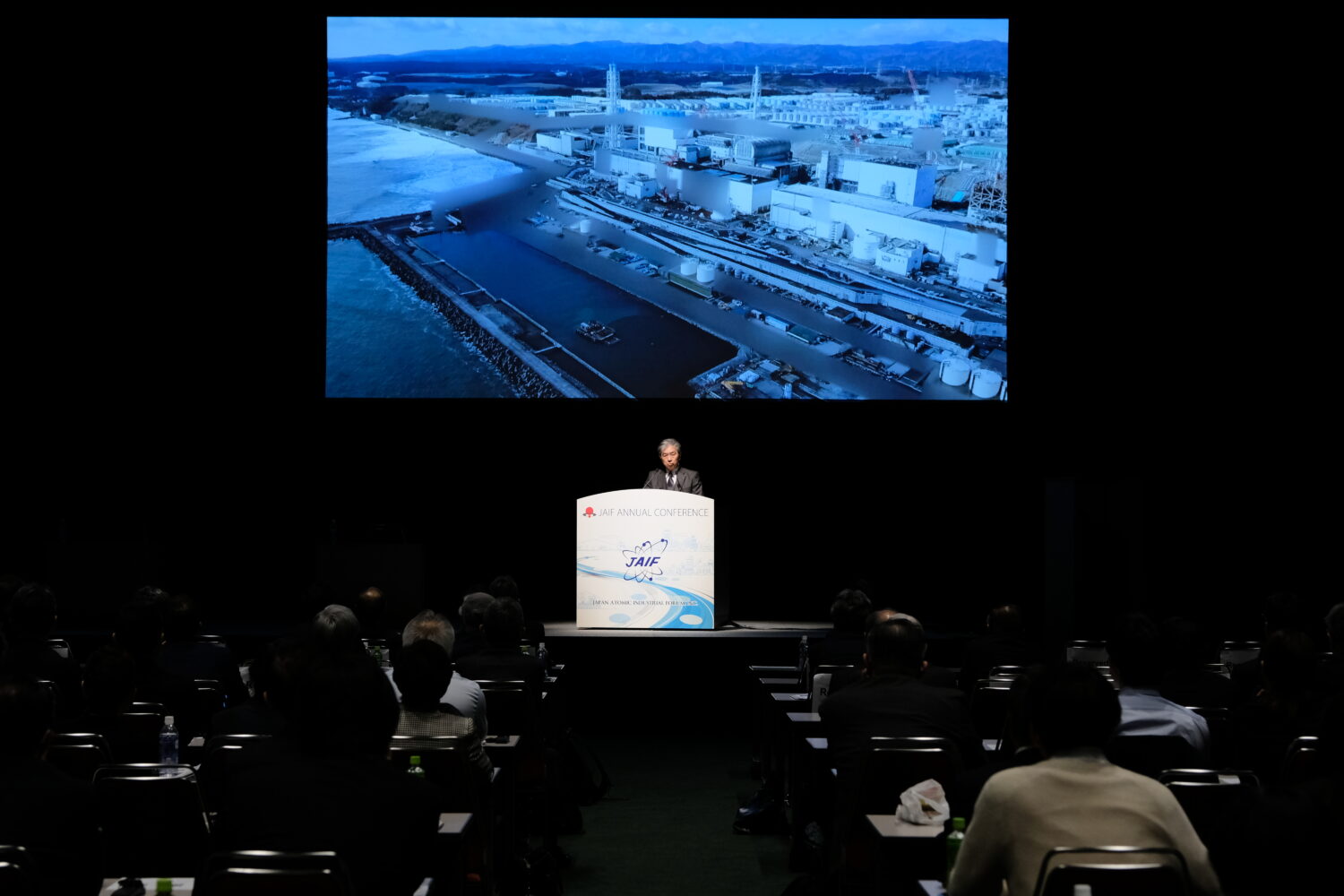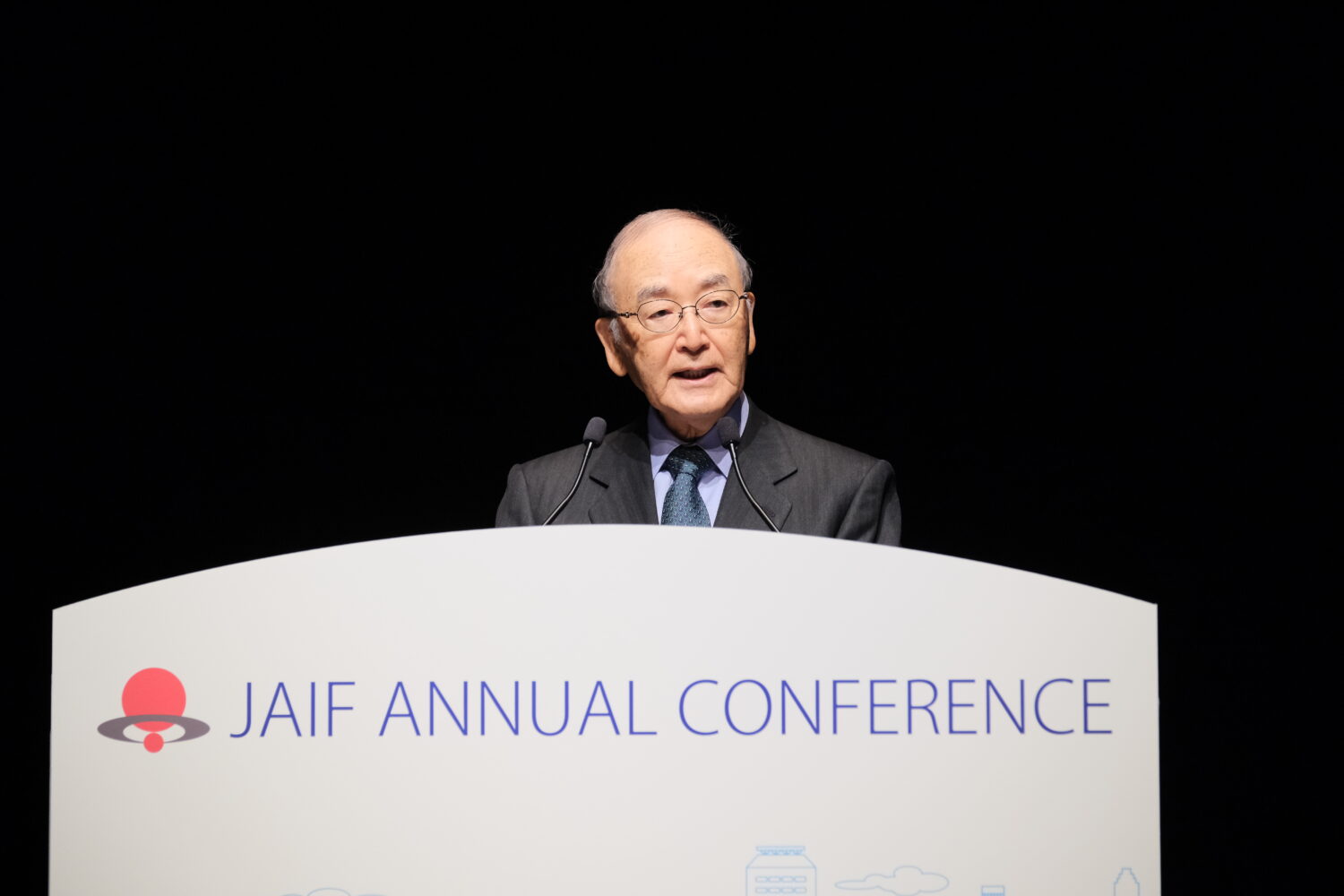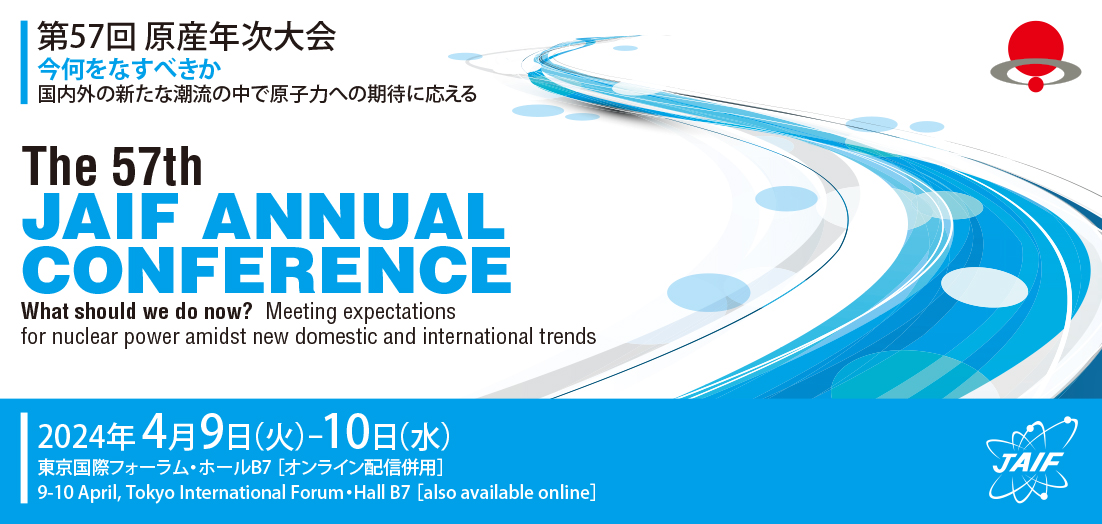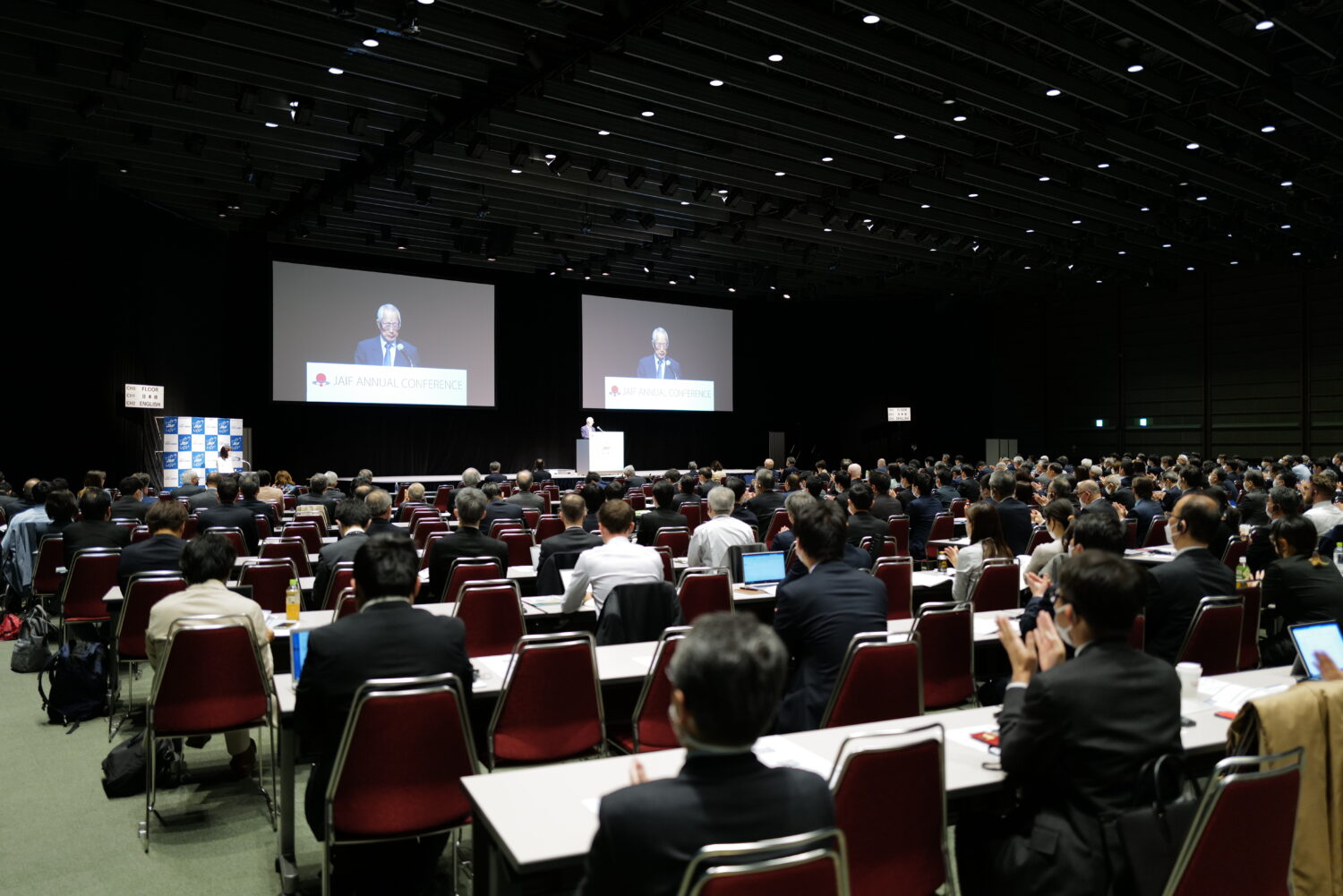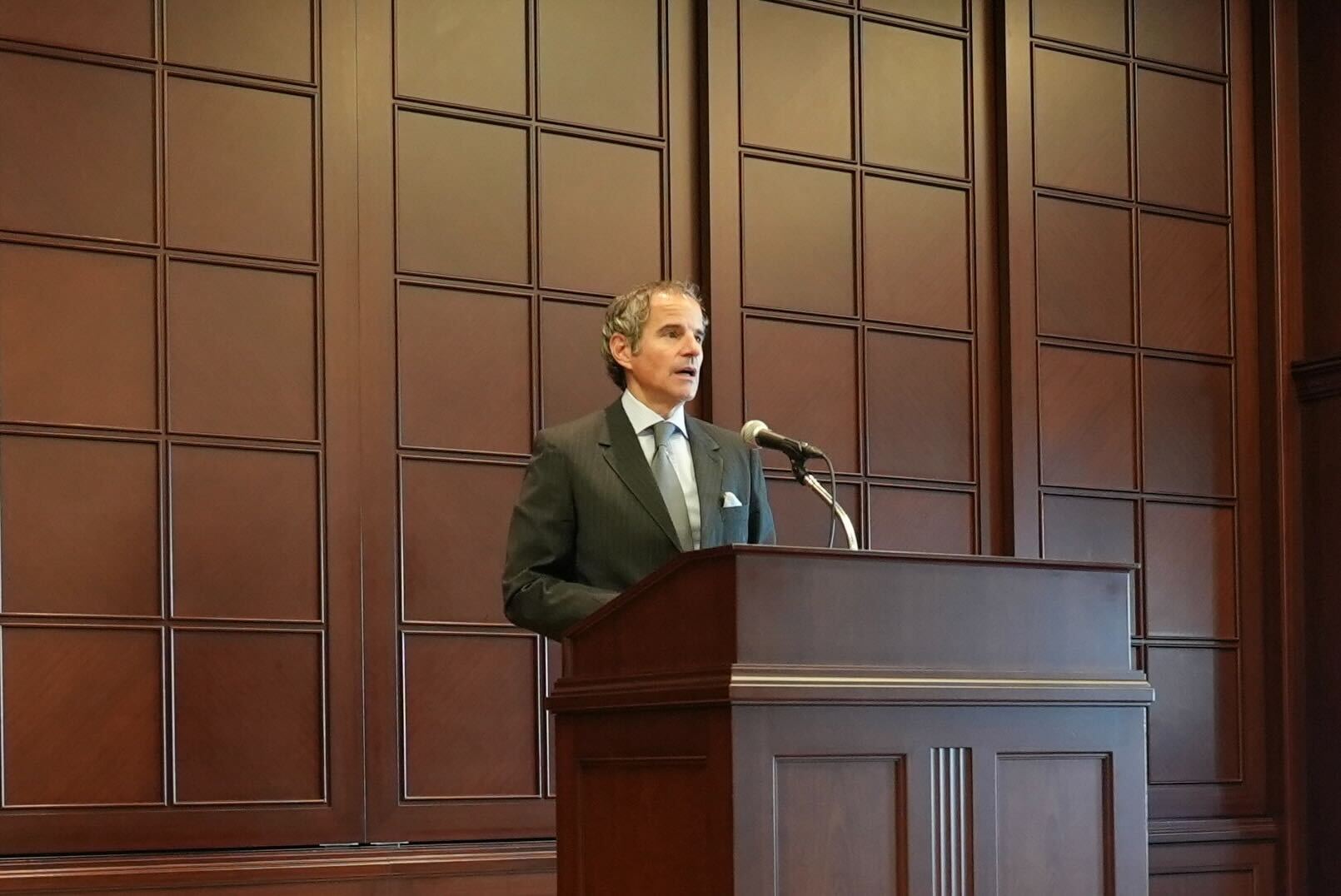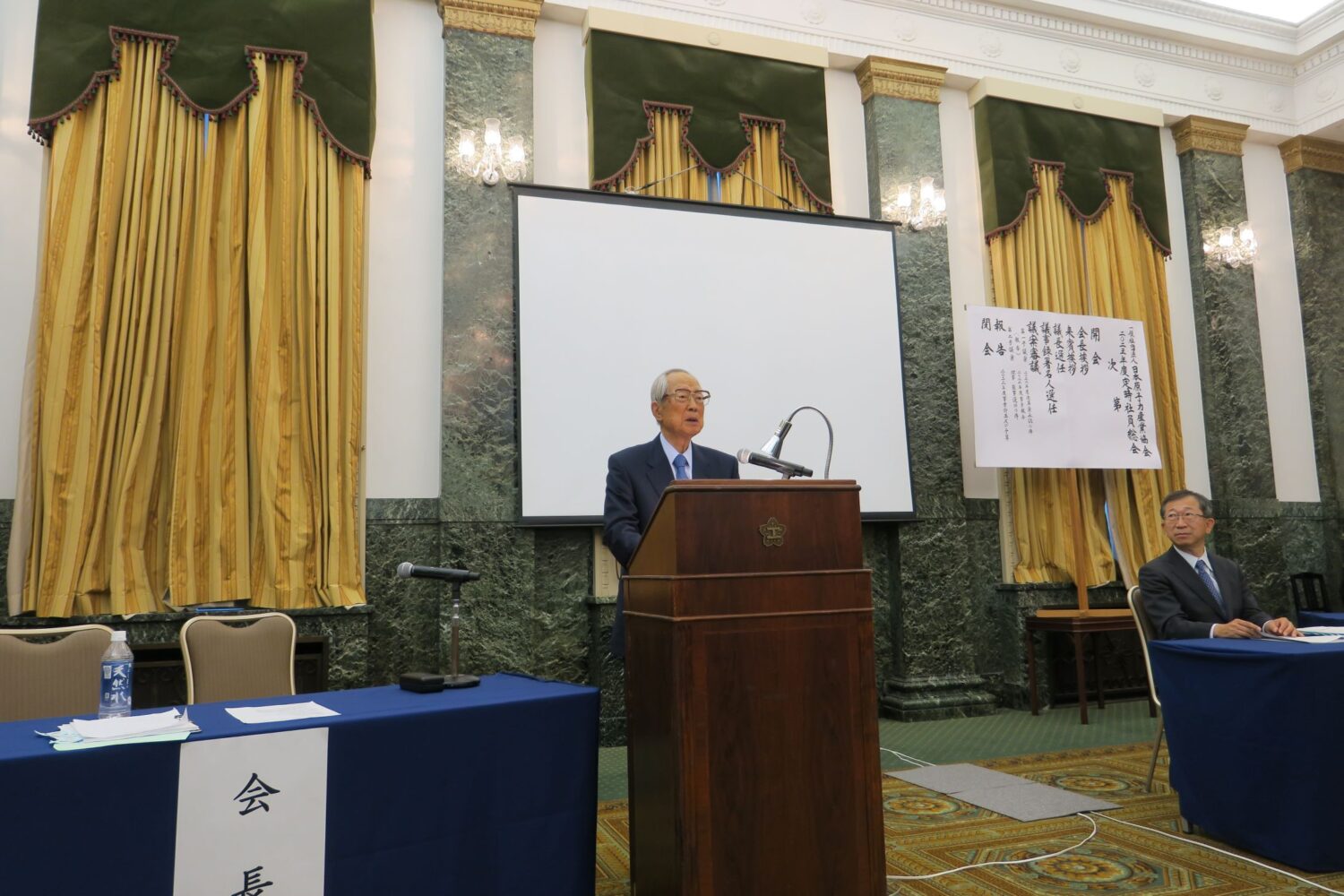First, Chief Economist Laszlo Varro of the International Energy Agency (IEA) explained the contributions of nuclear power to achieving a decarbonized society and the measures necessary to maintain it. To achieve the goal of “carbon neutral” by 2050, zero-carbon electricity will have to be sharply increased, as CO2 emissions from the power sector are the largest component, at more than 10 million tons.
Since shifting energy increases energy efficiency, it results in lower total energy consumption. However, 80 percent of current energy consumption is non-electricity, and it is quite hard to reduce the use of fossil fuels. The amount of electricity use will double, and power sources not emitting CO2 (including renewable energies) will certainly play a substantial role. Nuclear power will also play a useful role, but not in the context of competing with renewable energies. All kinds of technology must be used to realize a carbon-neutral society.
In other words, if countries continue investing in renewable energies, but stop investing in nuclear power, they will pay the price later. In 2019, the International Energy Agency (IEA) published a report on the role of nuclear energy in which it noted that more investment in nuclear power would be required than seen now. In the case of renewable energies, a large portion of investment is in the development of infrastructure, particularly power transmission networks. With nuclear energy, however, transmission networks are already used efficiently. Another great advantage of nuclear power is the comparatively small land area required to build each a power plant.
 At present, the economy of nuclear energy is a major issue due to deficiencies in regulation and market structure, and power plants have been forced to close one after another. A nuclear power plant (NPP) can be operated safely for sixty years or more, but must be duly evaluated to avoid unnecessary decommissioning. Given that the construction of new power plants requires a huge amount of early investment, private companies are hard pressed to raise the funds by themselves. That is the point at which the government is required to support nuclear energy. The government must also develop policies to ensure, for example, that nuclear energy is fairly evaluated in terms of carbon pricing. No less important is the promotion of technological innovation, including small modular reactors (SMRs), some of which are now at the demonstration stage of development. If SMRs are successful, they are expected to be beneficial both in terms of operation and investment.
At present, the economy of nuclear energy is a major issue due to deficiencies in regulation and market structure, and power plants have been forced to close one after another. A nuclear power plant (NPP) can be operated safely for sixty years or more, but must be duly evaluated to avoid unnecessary decommissioning. Given that the construction of new power plants requires a huge amount of early investment, private companies are hard pressed to raise the funds by themselves. That is the point at which the government is required to support nuclear energy. The government must also develop policies to ensure, for example, that nuclear energy is fairly evaluated in terms of carbon pricing. No less important is the promotion of technological innovation, including small modular reactors (SMRs), some of which are now at the demonstration stage of development. If SMRs are successful, they are expected to be beneficial both in terms of operation and investment.
For those countries that have already decided to phase out nuclear power, their options vary depending on their individual circumstances. On the other hand, for those countries where nuclear energy is accepted societally and historically, nuclear can be said to offer extremely broad options in economic terms as well.
 Next to speak at Session I was Michel Berthélemy, nuclear energy analyst in the Division of Nuclear Technology Development and Economics (NTE) at the OECD Nuclear Energy Agency (NEA), who gave a talk entitled, “Global Challenges Toward a Decarbonized Society.”
Next to speak at Session I was Michel Berthélemy, nuclear energy analyst in the Division of Nuclear Technology Development and Economics (NTE) at the OECD Nuclear Energy Agency (NEA), who gave a talk entitled, “Global Challenges Toward a Decarbonized Society.”
According to the Report of Tracking Clean Energy Progress (TCEP), published in 2020 by the International Energy Agency (IEA), the outlook for nuclear development is not on track. To realize the IEA’s sustainable development scenario (SDS), it is necessary to support the long-term operation of existing nuclear reactors, while also accelerating the construction of third-generation large reactors, small module reactors (SMRs), and the like. If nuclear power can be sustained, it could account for as much as half of zero-carbon generation by 2050.
It may be useful for the energy sector—where carbon neutrality is considered difficult—to deal with the issue by applying nuclear energy in areas other than electricity. Nuclear power has been used for heating in the past. The roadblock is not technological, but instead legal—getting permits and approvals—as well as realizing its interlinking and integration into present energy markets. Accordingly, nuclear energy has great potential to support the energy sector’s promotion of decarbonization.
For nuclear energy to exhibit its maximum capability in the low-carbon energy mixture, a “next set” of industrial policies will be necessary to implement in the future: (1) structural reform of the electricity market to promote decarbonization on a long-term basis, (2) direct and indirect approaches to government, given that governments support financing for building new NPPs, and (3) the establishment of an international framework for permits and approvals to promote the early development of SMRs.
Yet, the deregulation of the market alone cannot achieve low-carbon power sourcing. Financing low-carbon power sources is important, and investment in NPPs is of great significance. Previously, support for “procuring green” had meaning, but what is needed now is investment in energy markets. At least in the low-carbon transitionary period, national governments must financially support new NPPs, which are unable to attract long-term investment from the private sector. Among the reasons for that are societal and environmental factors, including effects on climate change, clean air, and the diversification of fuel.
Further technological innovation is required if nuclear is to remain competitive against other power sources, and to maintain its position as a flexible, reliable energy source able to adjust for changes in supply and demand. In addition to SMRs and advanced nuclear reactors, nuclear-related technological areas that are promising in the future include non-electricity uses, including hydrogen production and the desalination of seawater, as well as innovative nuclear fuels that combine excellent performance with lower cost. To accelerate the development of such innovative nuclear technologies toward commercialization, an international approval framework also needs to be supported. That will require cooperation at an international level, consistency in regulatory requirements, and design standardization.
 At Session 1, Director General Sama Bilbao y Leon of the World Nuclear Association (WNA) was the next to give a presentation. Entitled “Nuclear Technologies for a Clean Energy Future,” her talk highlighted the advantages of nuclear power.
At Session 1, Director General Sama Bilbao y Leon of the World Nuclear Association (WNA) was the next to give a presentation. Entitled “Nuclear Technologies for a Clean Energy Future,” her talk highlighted the advantages of nuclear power.
In recent years, the world has been forced to cut greenhouse-gas emissions substantially. Nuclear power plays a great role in the decarbonization of the power business. Minister Hiroshi Kajiyama of Japan’s Ministry of Economy, Trade and Industry (METI) said, “When Japan’s power supply was tight last January because of heavy snow, neither solar power nor wind power was reliable. The government will have to endeavor to make the public understand that nuclear power is eventually needed.” He recognized that nuclear power was essential to keep power prices low and avoid an insufficiency of supply.
METI, in its power generation plan issued in 2018, set a goal of greatly increasing the ratio of Japan’s renewable energy by 2030. The key for the country in achieving its clean energy goal is to promptly restart NPPs and to pursue their long-term operation. In the short term, the long-term operation of existing NPPs is important, and that is also the most cost-effective means for decarbonization. That fact was noted in last year’s reports by OECD/IEA and OECD/NEA.
New nuclear development projects are required for Japan to maintain its long-term clean power goals and support sustainable economic development. Nuclear power is the only low-carbon energy source that can supply both electricity and heat, thus helping the industrial sector—in which the reduction of CO2 emissions is difficult—to realize decarbonization. It can also generate hydrogen without emitting CO2, and high-temperature gas-cooled reactors (HTGRs) are advantageous in hydrogen production as well.
For all those reasons, it can be concluded that nuclear power will obviously play a central role in achieving global net-zero greenhouse gas emissions by 2050, and it is also clear that Japan should promote the restart of domestic nuclear reactors. Nuclear power can be a suitable power source for a country with limited usable land, such as Japan. Japan also possesses world-class technology for producing electric power on a large scale, as well as hydrogen, hydrogen-derived fuels, and others, by utilizing the process heat generated in HTTR. It also has suitable industrial infrastructure.
 Next, Keigo Akimoto, group leader and chief researcher at the Research Institute of Innovative Technology for the Earth (RITE), gave a presentation entitled, “The role of climate change mitigation measures and nuclear power towards carbon neutrality.”
Next, Keigo Akimoto, group leader and chief researcher at the Research Institute of Innovative Technology for the Earth (RITE), gave a presentation entitled, “The role of climate change mitigation measures and nuclear power towards carbon neutrality.”
In decarbonization, final energy should obviously be electricity or hydrogen (the latter of which is often used as in fuel cells, where the final form of its use is electricity). Decarbonization is still required, however, in the manufacture of hydrogen. Renewable energies, nuclear power, and fossil fuels exist as the primary energy for that. The use of fossil fuels for decarbonization requires carbon capture and storage (CCS).
As “zero carbon” is unrealistic, net-zero carbon requires offsets such as negative-emissions technologies, including the planting of trees, as well as the use of bioenergy and technology to control emissions, including CCS. At the same time, it is important to realize a low-energy-demand society that is economically self-reliant, given that excessive reliance on offsets reduces the possibility of achieving carbon neutrality. The transition process is also important. Both the damage from climate change and the costs that could be reduced as technological development progresses—and more—must be considered comprehensively, with effective decarbonization needing to be promoted at each stage.
Based on current technological and societal trends, increases in total energy demand are decelerating partially because of declining populations, making it difficult to take long-term, large-scale investment risks. In such circumstances, interest is growing in the development of SMRs, primarily in the United States. The possibilities are also increasing for utilizing dispersed energy sources at lower cost.
Turning one’s attention to renewable energies, costs have been substantially reduced, primarily for solar and wind power, and their large-scale expansion is essential. But large gaps remain in systems costs, making cost reduction important throughout the entire supply-and-demand response apparatus, including storage batteries and hydrogen.
Although various technologies, including nuclear energy, for supplying energy on a large scale continue to be important, the role of dispersed power sources and the digitized technology to link them is also expanding. Hence, it is necessary to recognize that the overall role of large-scale energy supply technology, including nuclear energy, is diminishing. While nuclear power is certainly an important option toward achieving a low-carbon society, it is also true that measures on the demand side for renewable energies—dispersed power sources—are playing a larger role, on the whole, in light of the development of technology and the increasing uncertainty of energy demand. The great issue for nuclear power now is how to escape the vicious circle of worsening capacity factors leading to increased costs and reduced competitiveness. While the restoration of societal trust remains urgent, a virtuous circle must be rebuilt.
 Next, Associate Professor Ryoichi Komiyama of the Department of Nuclear Engineering and Management at the Graduate School of Engineering in the University of Tokyo gave a presentation entitled, “Nuclear Energy Strategy for a Carbon-Neutral Society.”
Next, Associate Professor Ryoichi Komiyama of the Department of Nuclear Engineering and Management at the Graduate School of Engineering in the University of Tokyo gave a presentation entitled, “Nuclear Energy Strategy for a Carbon-Neutral Society.”
The transitional period for realizing carbon neutrality in the global energy system may last until the mid-21st century. Once it is achieved, though, focus will shift to “carbon negative,” a state in which CO2 absorption exceeds emissions. Nuclear energy is an important energy source that could contribute to that entire process.
From 2020 to 2021, liquid natural gas (LNG) spot prices rose sharply due to reduced supplies, combined with higher demand as a result of unexpected cold waves in gas-producing countries in northeast Asia. Accordingly, measures will become even more important for the stable procurement of LNG and to deal with tight situations for power supply and demand. China’s LNG imports have been increasing since 2017, and the country is expected to be the largest LNG importer in Asia by 2023. Because LNG is an important energy source in the transitional period toward carbon neutrality, nuclear energy is essential to reinforce energy supply guarantees.
The feasibility of Japan’s achieving carbon neutrality was assessed using an “energy-technology model.” If nuclear power can expand by 26GW before 2050 by constructing new nuclear reactors and replacing older ones, nuclear energy could be an economically rational option and contribute to achieving carbon neutrality. Given society’s increasing dependence on electricity, and the fact that the importance of stable power supplies will increase, nuclear power is an essential technological option to meet the demand for power. Also, when it comes to CO2 emissions, all technological options must be deployed toward the achievement of carbon neutrality. Nuclear power is a promising option.
An integrated assessment model known as DNE21 was used to determine the energy composition in the global energy system with the lowest overall cost. Using plutonium efficiently in fast reactors can reduce the volume of radioactive waste, lessening the burden on the environment and relieving pressure on the uranium supply. To hold the rise of global temperatures to 1.5℃ or less, CO2 emissions will have to be held at zero through the latter half of the 21st century. Even technologies enabling the direct capture of CO2 from the air, etc., will require large volumes of electricity and heat.
Currently, the nuclear industry is engaged in the development of SMRs and HTGRs. Together with renewable energies and technologies that not only capture and store CO2 but use it effectively (CO2 capture, utilization and storage, or CCUS), they may comprise part of a sustainable energy system utilizing dispersed SMRs, contributing to decarbonization and strengthening resilience. To realize such a sustainable energy system, it will be necessary to establish coexistent relationships wherein the strengths and benefits of each system can be used to offset the disadvantages of the others.
 In the panel discussions that ensued, Project Professor Jun Arima of the Graduate School of Public Policy at the University of Tokyo, who served as moderator, asked primarily the overseas panelists for any advice that they might have for Prime Minister Yoshihide Suga and METI Minister Hiroshi Kajiyama.
In the panel discussions that ensued, Project Professor Jun Arima of the Graduate School of Public Policy at the University of Tokyo, who served as moderator, asked primarily the overseas panelists for any advice that they might have for Prime Minister Yoshihide Suga and METI Minister Hiroshi Kajiyama.
IEA Chief Economist Varro pointed out, “When thinking of Japan’s geography and population density and the massive consumption of electricity by industry, it will be very difficult to promote decarbonization without nuclear power, because it would require significant costs.” Existing reactors should be restarted, while joining forces with the public is needed to work out such issues as safety and social acceptance.
WNA Director General Bilbao y Leon agreed by saying, “Japan should start by restarting its existing reactors.” She pointed out that it was important for the country to obtain a “social license from the public” to operate and continue NPP operation. Realizing the long-time operation of as many existing reactors as possible would also be necessary, she said, adding that in a sense, Japan now had a great opportunity, given the advantages afforded by its current know-how and infrastructure.
OECD/NEA Nuclear Energy Analyst Berthélemy similarly pointed to the need to give priority to the restart of NPPs, the long-term operation of existing reactors, and the recognition of a “social license.” The Japanese government has a responsibility, he said, to explain the benefits of nuclear reactors to the public. It should also take advantage of the cost-reduction measures that it has learned to use from past construction projects, and place priority on making a long-term plan toward the construction of new nuclear reactors.
At the end of Session 1, moderator Arima said, “A consensus has been obtained that nuclear energy will play an important role in achieving carbon neutrality.” While that goal might be achievable using renewable energies alone, it would be highly unrealistic because of costs and the need for supply guarantees.
He also said that since the 2011 accident at Fukushima Daiichi, “Japan has been adversely affected by a futile controversy pitting ‘renewable energy’ against ‘nuclear power,’ and it is never productive to argue that only renewable energy is acceptable in Japan, whose land is limited, and where energy supply guarantees are fragile.” Recognizing that (1) lowering renewable costs and digitalization are proceeding simultaneously, (2) the role of dispersed power sources is becoming more important, and (3) nuclear power alone cannot solve all the problems, he said that the positioning of nuclear energy should consider the combination of various decarbonization options and the substantially increased use of renewable energies.
The moderator then said, “This session has come to an agreement that the best measures from the viewpoint of cost-effectiveness are to restart suspended nuclear reactors as soon as possible and to have them operate for extended periods. If decarbonization were attempted using renewable energies alone, power rates would rise substantially.” Looking to the year 2050, the introduction of advanced reactors and the replacement of existing older reactors are certainly timely points for discussion. But new investments in them cannot be expected given the current circumstances of power market deregulation in Japan. Political incentives and market incentives are thus required.
Based on the above, Arima concluded, “The highest hurdle for Japan is public opinion. If decarbonization is attempted without nuclear power, the Japanese economy could self-destruct because of the costs. Now that the nuclear technology which Japan has nurtured over many years and the nuclear human resources needed to sustain it are both facing existential crises, the government must rationally and scientifically explain to the public, with a strong sense of responsibility, that the restart of existing reactors, the replacement of older ones, and the construction of new ones are all essential for the preservation of their lives, livelihoods, lifestyles, and the nation at large.”


